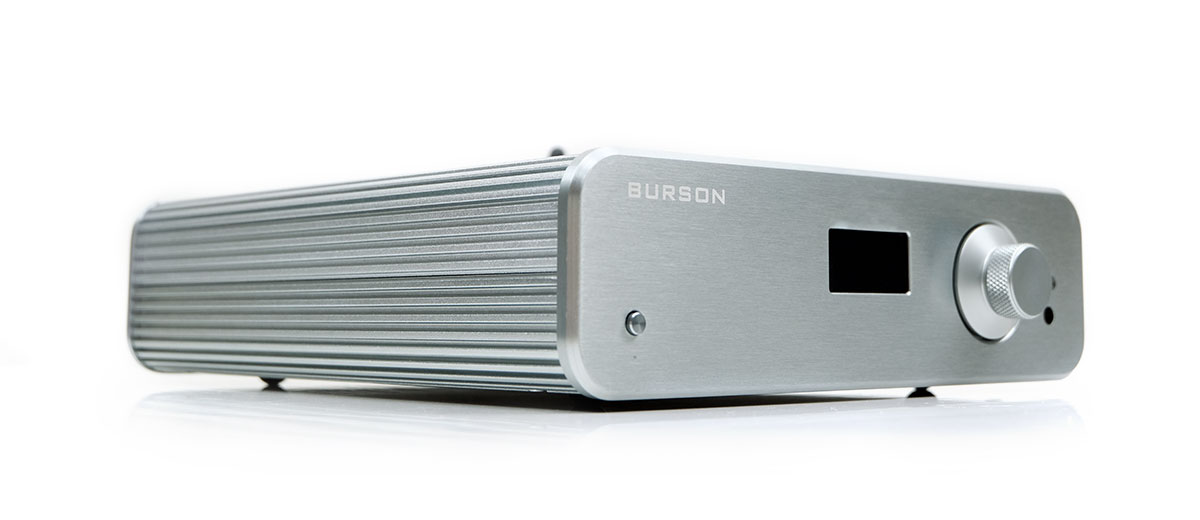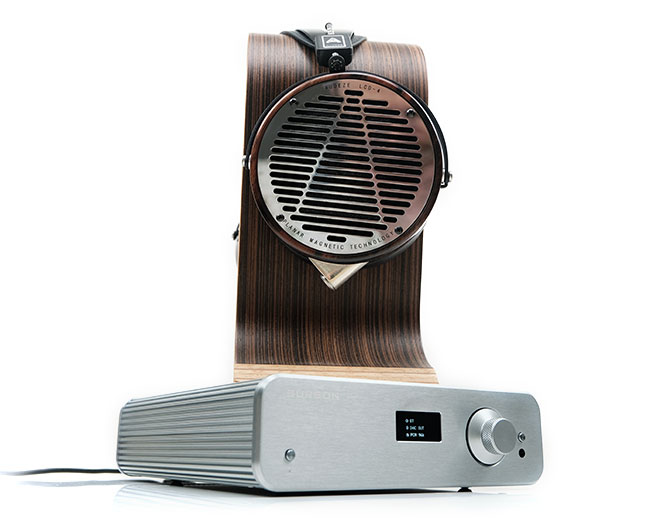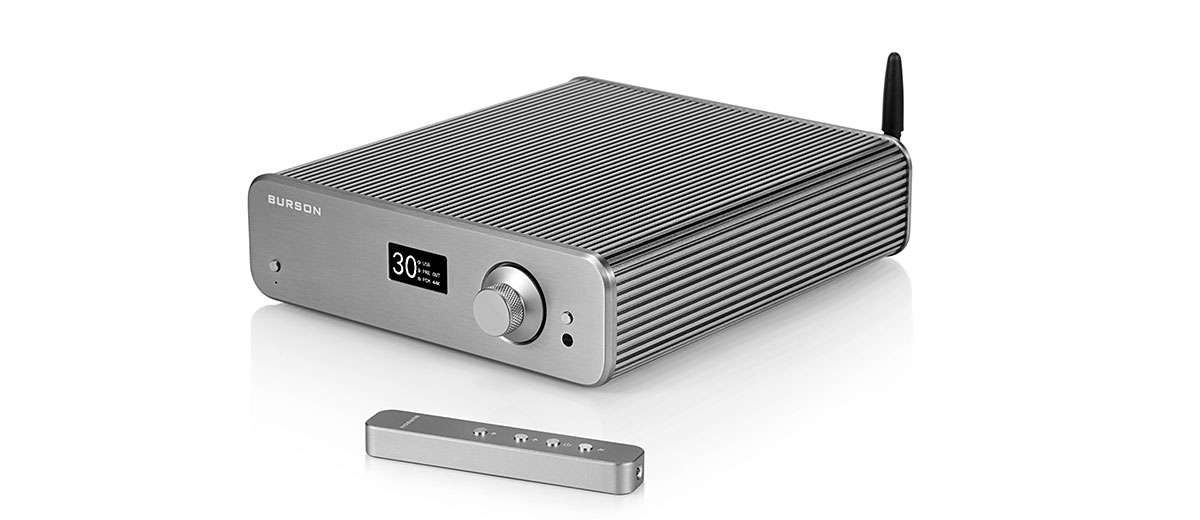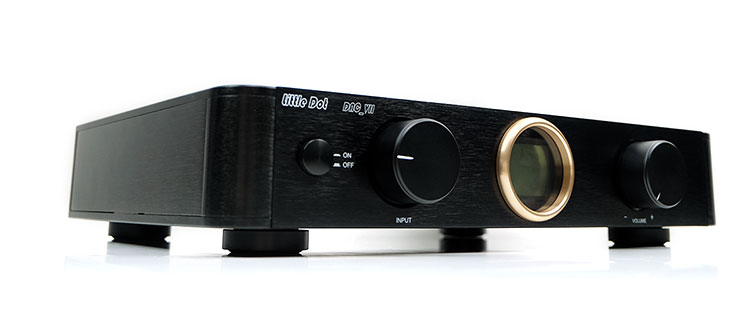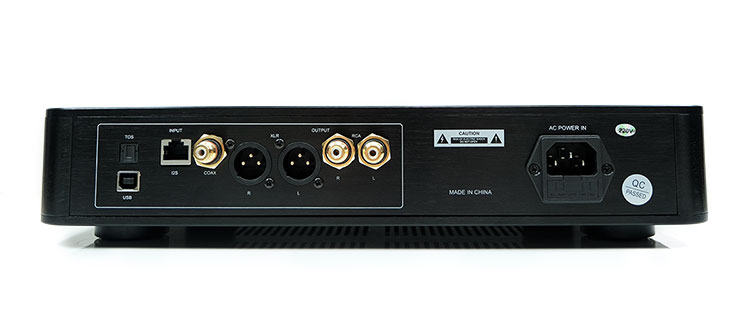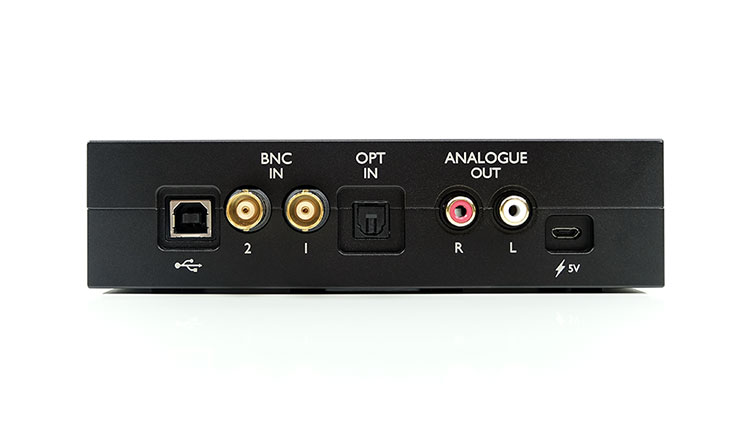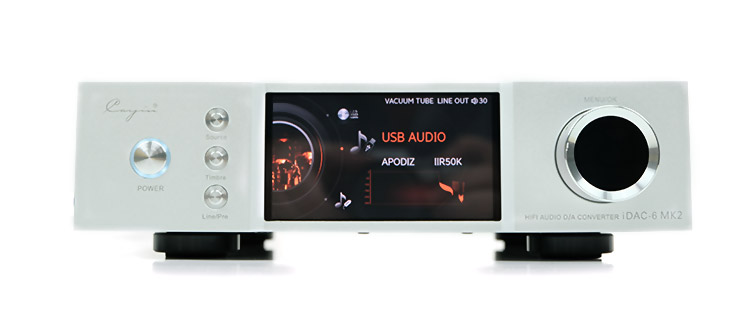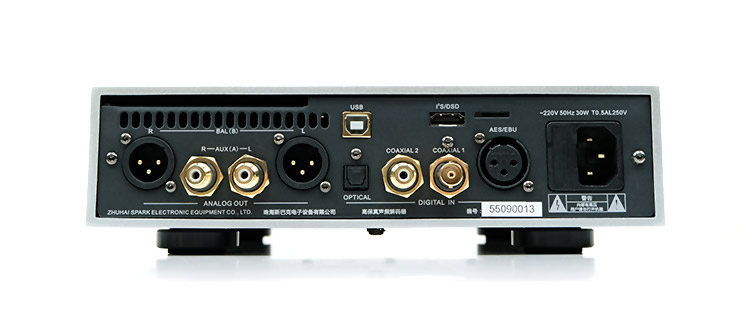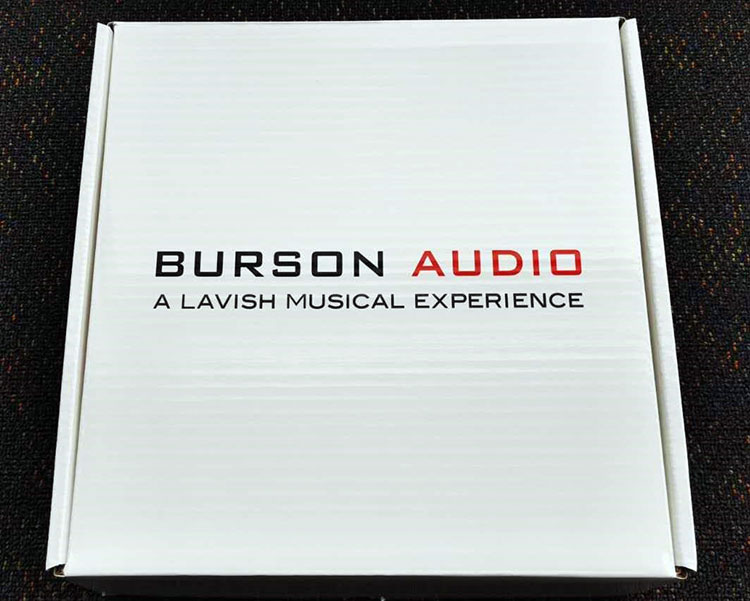Sound Impressions
(Tested using the Auris HA-2SE tube amp, Violectric V281, and the Formula S from Xi Audio)
Summary
As with any DAC, it is the sum of the parts and any amplifier you can throw at it will shape the final coloration. However, using rollable opamps, you can distinguish contrasting sound signatures inside the Composer 3X Performance.
Beyond the overall tone, there is also a complimentary technical discussion regarding just how good this DAC can be concerning instrumental separation and bass layering.
This is particularly so when using the V6 Vivid opamps which seems to emphasize the Composer 3X Performance’s excellent imaging and black background allowing it to tease out a fantastic level of detail in our tested amps low-end performance.
Granted, the V6 Vivid opamps do deliver what I term a high contrasting style that will emphasize height, and depth, and create a grander stage to ‘paint its muse on’.
However, it offers more than some sort of faux V-shaped parlor trick because whilst the lower mids are a shade ‘stand-off’ in positioning, they remain wonderfully clear and lack any of that frustrating or diffuse vagueness.
In its stock form, the Composer 3X Performance can sound effortlessly holographic with plenty of headroom.
Opamp Rolling
I think this is the secret in the Burson sauce and one of the compelling reasons why you should consider listening to the Composer 3X Performance. Both have their distinct colorations and they take about 2 mins to swap out with the majority of the time spent unscrewing the lid.
V6 Vivid
Right now the Composer 3X Composer comes with the four V6 Vivid opamps as stock and they deliver a high energy impactful sound signature. That means a punchy bass, a clean but precise midrange control with a bit more of an upper mids rise as well as a peppy treble presence to round it off.
Layering
One caveat, punchy it may be but that does not mean the Composer 3X Performance low-end is dense or weighty. Other DACs out there are richer and warmer such as the Little Dot DAC 7 or the Cayin iDAC-6 MK2.
For me, the V6 Vivid delivers a cooler timbre with a very clear emphasis on articulation and layering.
This is a complex but tight and very precise sounding bass response with a little less warmth traveling up into mids instrumental timbre. As a result, the mids are more high-fidelity in weight and a continuation of that cooler but precisely controlled theme.
You can offset the weight question nicely by pairing it with a weighty amp such as the Violectric V281 if you need more bounce on the low end.
This amp has plenty of low-end density so whilst the Vivid will not add to that density it does bring in some excellent control and a very black background. That will enhance the perceived dynamic range performance of the V281, especially if you go balanced.
Vocal “Walls”
One thing to note, the Composer 3X Performance Vivid vocals have some excellent focus despite the slight bass/treble emphasis. I suspect that is related to the level of separation the Composer 3X Performance can extract allowing vocals to easily command their own space and not get drowned out or seemingly smeared.
Female vocals in particular have some precise yet killer presence though at times the peppy treble can introduce a little attack roughness. Some emphasized sibilance can surface compared to more refined alternatives such as the Chord Qutest. This is compensated for by what I simply call “a wall” of vocals.
What do I mean by that? Say for instance harmonized female vocals and how they can be mixed to stretch out and wide. Well, the Burson signature brings that staging width and left-right separation to the fore in an impressive manner. It envelops you rather than casually presenting it a few feet away.
Treble might be the only weak link from the Vivid performance, though not concerning the headroom and articulation because it has plenty. Rather it can seep into the cooler, drier mids timbre and create a less forgiving tone for brighter female vocal recordings.
If you need your tone to be sweeter or more relaxing then I do suggest you try and grab the V6 Classic opamps which will soften those leading edges.
V6 Classic
And it just so happens we have 2 of these to throw into the mix (a combo of 2 Vivid and 2 Classic). Once you start using these you will notice some immediate changes in the Composer 3X Performance sound signature.
First the bass weight, there is less of a slam in the low-end, less of a punch in the mid-bass. Instead, you get something a little more relaxed, smoother, and warmer through to the mids. The changeup is more noticeable if you are A/B’ing the two opamps varieties or comparing them to a weighted DAC like the Cayin iDAC-6 MK2 or the Little Dot DAC VII.
You do lose a little staging depth and perhaps some of that razor-sharp clarity that goes with the Vivid presentation. I guess you could argue it has more of a SET ambiance to its overall tone and the Vivid is a more traditional transistor-type sound.
Mids Timbre
What is for sure is that firmer more intimate midrange. First, the instrumental timbre is wetter and sweeter in tone. I would not say denser, it is still a fairly light and breezy delivery and not hugely weighted which is not surprising given the reduction in bass quantity.
However, the midrange and treble liquidity are very palatable for my tastes as a vocal lover. With less treble aggressiveness, the Composer 3X Performance sibilance is softer, though not veiled. It also comes much closer to that refined and purer female vocal tone of the Qutest.
The beautiful thing about this change in timbre is that it does not come at the cost of staging width. You do get less depth and a shade less height but nothing sounds congested. Even if the vocal is more intimate those same backing track harmonized vocal deliveries sound as wide as ever.
Paired with the HA-2Se tube amp, an amp known for its mids sweetness, the Classics are an almost perfect SET match for euphonic female vocal timbre lovers.
Synergy
Pairing with amps is a lot easier with rollable opamps but the one overriding recommendation I would add before matching is to grab an amp that has excellent dynamic range and a black background.
The Burson’s attention to detail and the way it separates instruments so deftly will get lost if your amp is limited or compressed sounding.
That does not mean avoiding a SET or tube amp unless it is inherently noisy with headgear. Granted, the Composer 3X Performance balanced performance is better in terms of separation.
However, some SET amps we have here were very quiet and extracted some excellent detail. The Auris Audio HA-2SE as well as the Euterpe, (amp only), were very clean sounding with both the Vivid and Classic opamps.
Paired with the XI Audio Formula S was a beautiful experience. Even though a single-ended-only topology the Formula S has tons of power and a slightly sweet tone that works well with headphones like the 200Ω Audeze LCD-4.
I opted to go with the Classic V6 opamps with this solid-state TOTL amp just to keep that sweetness from going dry or losing any lower-mid warmth that I enjoy hearing from the LCD-4.
Of course, the LCD-4 can slam and the Vivid opamps will do that but the top-end of the LCD-4 starts to sound a little uneven for me with this pairing.
I tend to pair headphones such as the Empyrean or the HeddPhones from Hedd Audio which have meatier and smoother upper midrange signatures.
Line Out/Pre-Out
With regards to the Composer 3X Performance’s pre-out, gain control is an excellent bonus. I found the difference in the amount of current and headroom between its low gain and high gain useful for amp pairing where I need some additional ‘PRaT’ for harder-driver headphones such as the Abyss Headphones Diana V2.
Lowering the gain works a lot better for current control on low impedance higher SPL options such as the Hifiman Ananda. You can also opt to introduce some higher gain on the pre-out which I preferred over the fixed lineout performance.
That is not to say the fixed line-out was a weak alternative. Even though it is a standard 2Vrms unbalanced I found it to be a bit more vibrant and dynamic sounding than the Cayin iDAC-6′ MK2’s fixed unbalanced lineout alternative.
I will say, however, the Cayin’s pre-out is phenomenal with tons of voltage on demand (7Vrms) which the smaller Burson (max 4Vrms) did find hard to match.
Wireless Performance
The Burson Composer 3X Performance Bluetooth connectivity is a receiver only with no transmission capability so it does not bi-directional capability such as you would find in a DAP.
However, its BT5.0 module is capable of receiving up to LDAC PCM 24bit 96K which, aside from some ‘cooky’ formats like UAT, is as high as you can get for wireless transmission.
Pairing
Pairing is very straightforward with the two smartphones used in this review, a Samsung Note 9 and a Huawei P20. The two smartphones easily found the Composer 3X Performance ‘Burson BT’ label during the initial scan.
When paired both smartphones offered LDAC right away as a transmission option to the Burson which, of course, I turned on.
Stability & Range
I could class the distance you place your source away from the Composer 3X Performance Bluetooth signal as just about average and nothing world-class, at least compared to a good quality TWS link-up.
I got about 8 meters or about 2 meters less than your typical TWS/Smartphone distance with one wall in-between and beyond that, the signal stuttered and dropped out by around 11m.
You will likely need your BT source in the same room to ensure you get an optimal signal strength for the Composer 3X Performance BT.
Latency
The latency for media files using BT on the Composer 3X Performance is very good. Using some previous TWS reference media files with a 48kHz sample rate and 162kbps bit rate on a Windows laptop and VLC Media player required only a minor audio tweak.
What I mean by that is a ‘hastening’ adjustment of 0.2s or less which I often get with aptX capable TWS audio performances. Here I could handle 0.1s or less which I would rate as above average.
Select Comparisons
Little Dot DAC VII
$1399
The DAC VII has just arrived with us in the last week or two so my impressions are at a very early stage. Some measurements do not easily match up to the Conductor 3X Performance on paper as they are laid out in a very different manner. This is also Little Dot’s current pure desktop DAC flagship with pre-amp capability.
Technical
Inside both use an ES9038 DAC chipset though the VII uses a PRO version as opposed to the Composer 3X Performance’s 2-channel Q2M variant.
Sadly, beyond that Little Dot does not provide any in-depth detail on the actual implementation but given its size and weight, I would say this is a traditional and weightier SMPS power supply.
Opamps inside the VII are not rollable and I have to presume the I/V or L/P are not bypassed in the same manner as the Composer 3X Performance topology.
The decoding potential, however, is as good as the Burson with up to DSD512 native, (Amanero Combo384 Module), and PCM 32BIT/768kHz decoding capability. Neither are MQA compatible and the Little Dot DAC VII has no Bluetooth streaming capability.
On the performance side, both have pre-amp variable voltage and volume control suitable for power amp connectivity.
The Vrms is the same at 2V unbalanced and 4V balanced via a rear set of RCA and 3-pin XLR. I cannot give you an exact like for like labeling or even if the DAC VII is a weighted measurement but the dynamic range does look impressive at 132dB.
Connectivity
Both DACs can output an analog signal in balanced and unbalanced and both have USB, coaxial and optical connectivity. The DAC VII uses a traditional USB-B port as opposed to USB-C on the Burson.
The DAC VII does have an additional I²S port but it is not a typical HDMI pin slot but rather an ethernet-type RJ45 connection which might mean you need a crossed CAT5 cable rather than a regular 1-1 CAT 5.
Whether or not it will accept an RJ46 to HDMI adapter compatible with the implemented I²S standard I am not entirely sure but will find out for our main review next month.
Controls
Both these DACs have a fairly basic but legible LCD interface with some front panel controls. However, I find the Composer 3X Performance control set to be far easier to understand and manage. This is not a lack of familiarity as I did not really check the manuals of either before operating them.
The DAC VII does allow you to switch sources and control volume from two chunky dials on the front panel and that is the easy part. The hard part is that everything else is on a flimsy remote control that has no labeling and unpredictable results from button mashing.
The LCD light does dim on the DAC VII when not in use, that could be a bonus for some as the Composer 3X Performance is in an always-on state.
Design
The DAC VII is a big traditional almost mechanical sounding pure black desktop DAC. It is much bigger and heavier than the compact Composer 3X Performance. You could argue the DAC VII design is grandiose, high-end in a way but also old-school HiFi in another way.
It feels incredibly solid but then we do know the Composer 3X Performance is also a very sturdy little DAC design. One thing to note is the volume control on the DAC VII which is not a limited mechanical dial from left to right.
You can technically swing it 360 without ever hitting any physical stop so be careful with your volume settings (LCD display) when in pre-out mode.
Both do have remote controls but the Burson remote design is tastier with a full aluminum chassis and clear labeling for functionality. The DAC VII remote is an odd white plastic creation with minimal labeling.
V6 Vivid Performance
With the stock V6 Vivid opamps, the Composer 3X Performance is the more neutral of the two DACs through to the mids but with a slightly more treble energy and presence. Honestly, I was not surprised given the propensity of the Vivid opamps to sound lively up top.
However, what did surprise me was the DAC VII low-end density and sub-bass extension on the HA-2SE. There is a bit more warmth and more sub-bass quantity and this does ‘shine through’ on the HA-2SE/Ananda pairing very easily.
As a result, the DAC VII sounds the more rounded of the two for timbre. It has more low-end warmth and power with slightly less treble meaning the mids take on more of a liquid and richer texture to instrumental and vocal notes.
It can seem more intimate as a result because of the solidity and forwardness of the bass response but in actuality I found the imaging to be very good in terms of depth and width.
What I did find was the V6 Vivid performance to offer a bit more headroom and a livelier percussion timbre. This is a cleaner sound, perhaps not as much depth as the VII comparatively speaking but it has this fast, articulate feel with excellent separation.
V6 Classic Performance
The V6 Classic dual opamps do not tip the balance in terms of a timbre match with the DAC VII, especially on the low end. The DAC VII was already heavier and denser on the low end compared to the punchier Vivid opamps so it is even more emphasized now given the V6’s more neutral bass quantity.
What has changed is the mids and treble timbre to be a little less transistor type with the Classics and offer a smoother sound. It still has more treble energy but marginally wetter and with a more prominent midrange presence.
As a result, imaging is a bit further forward for vocals still but the DAC VII still delivers the perception of a bit more chest, bit more low-end roundness adding a lot of texture and weight to breathy vocals.
The Composer 3X Performance vocal timbre is sweeter and lighter with more of a mixed voice tone to those same vocals, especially falsetto.
Chord Electronics Qutest
£1195
The Qutest was sometime in 2018 and is still a top-performing desktop DAC, especially when stacked with the Hugo M Scaler. Even on its own, however, it is highly competitive albeit a stripped-down DAC experience.
Technical
The DAC implementation inside the Qutest is vastly different from the Composer 3X Performance design.
The Qutest has an in-house DAC design that uses an FPGA Xilinx Artix 7 chipset implementation to focus on Chord’s Watts Transient Aligned filter (WTA) tap-length capability. This is a direct contrast to the Composer 3X Performance delta-sigma ES9038Q2M implementation with an I/V and L/P bypass using discreet rollable opamps.
The arguments for the FPGA by Chord are not just related to a superior tap length to delta-sigma, (49,152 using a 10-element Pulse Array design), but also complete control of the design process that traditional block delta-sigma designs tend to restrict.
However, Burson’s bypassing could also be argued as doing something relatively similar, especially when combined with the rollable opamp and MCPS power supply. The only key digital limitation is the more restrictive tap length (100’s instead of 1000’s).
On its own, however, the Cutest is equally competitive to the Composer 3X Performance with both offering digital filters and a top-tier decoding level of PCM up to 32BIT/768kHz with native DSD512. Neither offer MQA and I do know Rob Watts is not a fan of this format so you are unlikely to ever see this featuring on a Chord product.
Connectivity
Other key differences are the inclusion of Bluetooth or a wireless feature on the Burson as well as the offering of a balanced XLR output. The Qutest has no streaming capability or balanced output but you can adjust the voltage levels on the unbalanced lineout from 1-3V.
On the digital wired side, both offer optical and coaxial connectivity (Qutest via single BNC), however, the Qutest can upscale via a dual BNC connectivity option which allows it to take on a modular dimension for pairing with Chord Hugo M Scaler.
Interestingly, both DACs have non-standard USB connections with the Qutest using an older micro-USB connection for power and the Composer 3X Performance a USB-C for connectivity.
Performance Numbers
It is a little hard to produce a direct comparison between these two aside from the cited channel separation which is very good for both at 142dB @1KHz and 135dB @20KHz for the Composer 3X Performance and 138dB at @1kHz for the Qutest. THD is also very close at <0.0017% for the Burson and <0.0001% for the Chord at a @1kHz weighting.
Note, the Qutest has no pre-out capability so no volume control option. Instead, it has 2 fixed lineout voltage levels from 1v, 2V, to 3V. The Composer 3X Performance varies its lineout with the single-ended 2V and balanced 4V outputs and does offer a pre-out volume-controlled option.
Design
Both DACs are sort of bare-bones DACs in terms of aesthetics though the Qutest does feel the more refined in terms of its aluminum block finishing. It is also very much the smaller of the two but with a more complex operating system.
The Composer 3X Performance LCD is basic but legible in terms of understanding what status you are on and where you can go with the multi-function potentiometer. The Qutest uses the orb color system which is less intuitive and you do need the manual for a while until you are familiar with each color code.
V6 Vivid Performance
I have always said the Chord Electronics Qutest is a fairly dynamic and excitable signature, with a little uptick on the treble compared to the more neutral Hugo 2. However, compared to the Vivid stock signature inside the Composer 3X Performance I actually found it comparatively neutral.
Even with the incisive neutral filter on the Qutest 2 it still felt the more liquid and slightly wetter of the two performances. Not by a huge amount and not to the same level as the Little Dot DAC VII but just enough to take the sting out of natural sibilant emphasis.
The Composer 3X Performance felt punchier on the low end but also brighter and more vibrant on the high end. If you are an EDM you should hear that difference shine through particularly with old school trance where I felt the energetic low-end Burson Vivid sound was the more fun sounding of the two.
Vocals
Another difference that stood out for me was female vocals or those that sat a little higher and pulling more from the odd harmonic upper order.
On the Qutest these were a shade rounded, refined, and controlled sounding. It did not mask the sibilance but neither did it emphasize it. You could argue it sounds incredibly accurate but others might call that boring.
The Composer 3X Performance, on the other hand, sounded more forward with vocals on the HA-2SE using the Ananda pairing. It was like the vocalist opened up their chords a bit more, slightly less head voice and more mixed and broader in texture. It can sound more exciting, but at the same time, slightly less controlled with more odd-harmonic sibilant emphasis.
A great example of this is Agnes Obel’s Riverside recording and her intonation on the ‘side’ part of the word ‘riverside’ during the song. On the quiet parts and possibly due to the mixing the S is a little squeezed resulting in a thin ‘S’ with more sibilance coming through.
The Qutest will play it back ‘as is’ but the Composer 3X Performance will push the word further forward and emphasize that a bit more.
V6 Classic Performance
The first thing I wanted to hone in on right away is the way the Classics changed Agnes Obel ‘S intonation on her ‘Riverside’ track, something which the Vivid tended to give emphasis to and enhance the sibilant levels compared to the Qutest.
This time around it sounds a lot more natural, palatable to the easy-going ear, and almost on par with the Qutest treatment of the same track with the same amplifier and headphones (Hifiman Ananda/Auris Audio HA-2SE).
The bass weight is comparatively reduced using the Classics with the Qutest sounding a little firmer on the low-end and with a bit more definition. Through the mids and treble, the Classics will also sound the more relaxed and euphonic of the two sound signatures with a slightly softer attack in lower-mids instrumental notes.
Vocals do sound a little further forward using the Classics compared to the Qutest but that goes with its greater mids intimacy emphasis compared to the Vivid higher bass/treble contrast.
Cayin iDAC-6 MK2
$999
The iDAC-6 MK2 is a Cayin 2nd generation desktop orientated DAC and an integral part of their ‘i-series’ component system, (iHa-6 and iDAp-6 being the other 2 system components).
Technical
Both DAPs have a similar price point with pre-amp and pure DAC capability. They also both use Sabre DAC implementations with native DSD512 and PCM 32BIT/768kHz decoding. Beyond that, however, these two DACs have some very different approaches.
Internally, the iDAC-6 MK2 uses a delta-sigma based Sabre ES9028PRO DAC chipset backed up by a triple Femtosecond Crystal Oscillator design.
Though technically lower than the ES9038 series it is the full PRO version compared to the mobile series ES9038Q2M inside the Composer 3X Performance.
That means 8 channel capability compared to just 2 channels inside the Q2M and on the flip side, the Q2M is much less power-hungry compared to the PRO.
Outside of that, and though both have similar decoding capabilities, the implementation of these 2 chipsets in each unit is quite different. The iDAC-6 MK2 uses a classic linear toroidal power supply design whereas the Composer 3X Performance opts instead for Burson’s Max Current Power Supply (MCPS) with switching resistors.
Timbre Control
Interestingly, both do have timbral control but once again, a very different implementation method. The iDAC-6 MK2 allows you to choose from 2 timbral presets, a solid-state transistor mode, and a vacuum tube timbre option via a mix of IC opamps and a quad triode 6N16B tube buffer.
The Composer 3X Performance opts instead for opamps, not just to flavor the timbre but also bypass the DAC’s own current/voltage (I/V) conversion stage and handle the low-pass filter.
Just to note though that out of the box you only get one flavor from the Composer 3X Performance and you do have to buy alternative opamps to change that timbre.
I/O
Both DAC’s offer unbalanced and balanced analog outputs as well as optical, USB, and coaxial connectivity.
However, a few additions on the iDAC-6 MK2 side that include an additional coaxial connection, I²S, and AES/EBU. The iDAC-6 MK2 also uses a traditional USB-C port compared to the USB-C socket on the Composer 3X Performance.
The two DAC’s also have a front panel LED menu system with multi-function potentiometer volume and function control. I have to say the iDAC-6 MK2 OS and IPS panel is much more involving and easier to use but it all comes without a remote control which the Burson does have.
Performance Numbers
Numbers are a little skinnier on the Burson side but it does seem the stock Vivid V6 setup has a superior official channel separation rating of 142dB @1KHz, and 135dB @20KHz compared to the iDAC-6’s official rating of 92dB for both balanced and unbalanced outputs.
Noise is quite similar on the analog pre-out side with the iDAC-6 MK2 rated at ≤0.002% for the transistor side both balanced and unbalanced compared to <0.0017% for the Composer 3X Performance.
Line-out noise performance is a little higher at ≤0.003% for the Cayin and though we do have a lower DAC THD+N for the Burson at 0.0005% @ 1KHz, 0dBFS it is not clear if this is specifically for the Composer 3X Performer’s lineout.
The Vacuum output performance for the iDAC-6 MK2 is understandable lower for noise compared to the Composer 3X Performance.
Voltage levels for both balanced and unbalanced line out seem to be close with the Composer 3X Performance at 2V unbalanced and the iDAC-6 MK2 marginally stronger at 2.2V. Burson does not list the balanced output but we must presume it is 4V compared to the Cayin rating of 4.4V (double).
One thing in the bag for Cayin is the pre-out rating of up to 7V specifically or power amps whereas the Composer does not offer that enhanced setting.
Design
Hugely different. The iDAC-6 MK2 is more of a traditional heavier blocky style of aluminum encasing compared to the more compact and lighter rounded aluminum Composer 3X Performance casing.
That does not mean the Cayin is poorly built. Far from it, the finish is actually better in part, particularly the rear panel which seems finished to a higher standard with better labeling. The IPS panel on the Cayin DAC is also vastly superior to the basic tiny LCD on the Composer.
Of course, Burson has crafted the Composer 3X Performance to be discreetly taken apart to allow you to roll those opamps so the screws on the underside are more exposed.
V6 Vivid Performance
The iDAC-6 MKII Transistor timbre is a little closer to the DAC VII from Little Dot in terms of low-end power and warmth and less neutral than the Chord Qutest.
The Composer 3X Performance Vivi performance is a little lighter and cleaner in the mids in terms of timbral density and not as warm either on the low-end but does have a better mid-bass impact and perceived definition. It also has a calmer upper mids and treble delivery with a bit more separation.
You could argue it is the tighter of the two on the low end with a bit more clarity and a tighter sounding decay. Certainly, on our HA-2SE/Ananda pairing the Composer 3X Performance just sounded the nimbler of the two DACs through to the lower-mids though also a bit drier.
The Burson also throws out a bit more staging width than the Cayin transistor mode, particularly with female vocals or with harmonized vocal layering. There were a few instances I felt the Cayin just reigned it in a little sounding smooth but a bit more centered whereas the Burson was solid but created a wider image, like a ‘wall’.
Doubtless, there is a little more treble extension on the Composer 3X Performance but it is more nuanced than obvious, with more air, separation, and upper mids clarity than a hugely brighter timbre.
Vacuum Timbre
Switching to vacuum timbre mode on the Cayin lightens the bass weight a little and comes closer to the Burson in terms of quantity but still remains a little wetter and warmer. The Burson is the punchier of the two signatures here on the low end.
The mids are sweeter on the Cayin, with a bit more presence, and not quite as dry as the Burson V6 Vivid timbre but more relaxed through the upper mids and treble.
Vacuum mode also drops the energy from the top end a bit more so vocals fall back a little with the Composer 3X Performance sounding more forward, with a shorter decay and better separation.
V6 Classic Performance
Switching to the V6 Classic opamps inside the Composer 3X Performance repositions the sound to somewhere in between the iDAC-6 MK2 transistor and vacuum tube albeit both still have slightly less vocal presence compared to the Classics.
The key here is timbre. The V6 smoothens out the mids timbre, injects a little sweetness, and brings them a shed further forward. Treble and bass intensity drops off a little hence that closer positioning to the Vacuum timbre of the iDAC-6 MK2.
Staging width and texture in those imaging cues far out wide is superior. The Cayin still sounds a shade centered as if you threw in a bit more crosstalk and pulled it tighter. The separation and imaging on the Burson with the V6 are close but wide.
I still think the Cayin has a bit more low-end density and lower-mid warmth compared to the V6 inside the Composer 3X Performance but beyond the V6 mids sweetness and a clever treble balance are exquisite.
Our Verdict
I am very surprised by what Burson has achieved here with the Composer 3X Performance despite my hesitancy over them using the Q2M version of the ES9038. Their opamps are easily the star of the show here and they do go to prove how much a proper DAC implementation can lift and transform any DAC chipset performance.
We will have personal preferences and though the Vivid V6 are the stock opamps with the Composer 3X Performance I do encourage you to try the Classics in there as well.
Overall, I tend to use the Classic opamps more often than not for their creamier or sweeter midrange and vocal performances. However, if you want something more explosive, planted and with more contrast then the Vivid opamps will give you that.
And yes, this is one durable but compact little DAC and right on the money in terms of how it fares with some of the competition. The addition of Bluetooth may well be a modern-day consumer lifestyle bonus but the wired performance is really excellent.
Burson Composer 3X Performance Specifications
Measurement |
Package Content |
||
| Input impedance: | 38 KOhms | Composer 3X Performance. Model # M-80X |
USB Cable |
| Frequency response: | ± 1 dB 0 – 58Khz | Remote Control | OTG Adaptor |
| THD: | <0.0017% | RCA Cable | 24V Power Unit |
| Output impedance (Pre Out / DAC Out): | 10 Ohm / 25 Ohm | Power Cable | |
General |
|||
| Inputs: | USB, Optical Toslink, BlueTooth 5.0, microphone | Weight: | app. 3 kg |
| Outputs: | 1 x XLR Pre Out / DAC Out 1 X RCA Pre Out / DAC Out |
Dimensions: | 200 X 250 X 60(mm) |
DAC Spec |
Asynchronous Isochronous USB Spec |
||
| Channel Separation: | 142 dB @ 1KHz, 135 dB @ 20KHz | Desktop OS: | Windows XP, 7, 8, 10 Mac OSX |
| THD+N: | 0.0005% @ 1KHz, 0dBFS | Desktop OS: | iOS* , Android (OTG support) |
| COAX & Toslink / SPDIF : | up to 24bit 192K | PCM Support: | PCM ? 768kHz @ 16, 24 or 32bits |
| Native DSD: | Native DSD 64 / 128 / 256 / 512 | ||
Bluetooth Input |
Bluetooth 5.0 aptX HD (Qualcomm CSR8675) |

